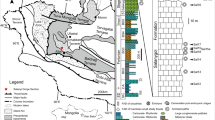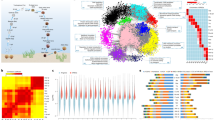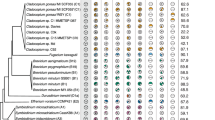Abstract
Phosphorites of the Ediacaran Doushantuo Formation (∼600 million years old) yield spheroidal microfossils with a palintomic cell cleavage pattern1,2. These fossils have been variously interpreted as sulphur-oxidizing bacteria3, unicellular protists4, mesomycetozoean-like holozoans5, green algae akin to Volvox6,7, and blastula embryos of early metazoans1,2,8,9,10 or bilaterian animals11,12. However, their complete life cycle is unknown and it is uncertain whether they had a cellularly differentiated ontogenetic stage, making it difficult to test their various phylogenetic interpretations. Here we describe new spheroidal fossils from black phosphorites of the Doushantuo Formation that have been overlooked in previous studies. These fossils represent later developmental stages of previously published blastula-like fossils, and they show evidence for cell differentiation, germ–soma separation, and programmed cell death. Their complex multicellularity is inconsistent with a phylogenetic affinity with bacteria, unicellular protists, or mesomycetozoean-like holozoans. Available evidence also indicates that the Doushantuo fossils are unlikely crown-group animals or volvocine green algae. We conclude that an affinity with cellularly differentiated multicellular eukaryotes, including stem-group animals or algae, is likely but more data are needed to constrain further the exact phylogenetic affinity of the Doushantuo fossils.
This is a preview of subscription content, access via your institution
Access options
Subscribe to this journal
Receive 51 print issues and online access
$199.00 per year
only $3.90 per issue
Buy this article
- Purchase on Springer Link
- Instant access to full article PDF
Prices may be subject to local taxes which are calculated during checkout



Similar content being viewed by others
References
Xiao, S., Zhang, Y. & Knoll, A. H. Three-dimensional preservation of algae and animal embryos in a Neoproterozoic phosphorite. Nature 391, 553–558 (1998)
Xiao, S. & Knoll, A. H. Phosphatized animal embryos from the Neoproterozoic Doushantuo Formation at Weng’an, Guizhou, South China. J. Paleontol. 74, 767–788 (2000)
Bailey, J. V., Joye, S. B., Kalanetra, K. M., Flood, B. E. & Corsetti, F. A. Evidence of giant sulphur bacteria in Neoproterozoic phosphorites. Nature 445, 198–201 (2007)
Bengtson, S., Cunningham, J. A., Yin, C. & Donoghue, P. C. J. A merciful death for the “earliest bilaterian,” Vernanimalcula. Evol. Dev. 14, 421–427 (2012)
Huldtgren, T. et al. Fossilized nuclei and germination structures identify Ediacaran “animal embryos” as encysting protists. Science 334, 1696–1699 (2011)
Xue, Y., Tang, T., Yu, C. & Zhou, C. Large spheroidal chlorophyta fossils from the Doushantuo Formation phosphoric sequence (late Sinian), central Guizhou, South China. Acta Palaeontol. Sin. 34, 688–706 (1995)
Butterfield, N. J. Terminal developments in Ediacaran embryology. Science 334, 1655–1656 (2011)
Hagadorn, J. W. et al. Cellular and subcellular structure of Neoproterozoic embryos. Science 314, 291–294 (2006)
Yin, L. et al. Doushantuo embryos preserved inside diapause egg cysts. Nature 446, 661–663 (2007)
Cohen, P. A., Knoll, A. H. & Kodner, R. B. Large spinose microfossils in Ediacaran rocks as resting stages of early animals. Proc. Natl Acad. Sci. USA 106, 6519–6524 (2009)
Yin, Z. et al. Early embryogenesis of potential bilaterian animals with polar lobe formation from the Ediacaran Weng’an Biota, South China. Precambr. Res. 225, 44–57 (2013)
Chen, J.-Y. et al. Complex embryos displaying bilaterian characters from Precambrian Doushantuo phosphate deposits, Weng’an, Guizhou, China. Proc. Natl Acad. Sci. USA 106, 19056–19060 (2009)
Xiao, S., Knoll, A. H., Yuan, X. & Pueschel, C. M. Phosphatized multicellular algae in the Neoproterozoic Doushantuo Formation, China, and the early evolution of florideophyte red algae. Am. J. Bot. 91, 214–227 (2004)
Xiao, S., Zhou, C., Liu, P., Wang, D. & Yuan, X. Phosphatized acanthomorphic acritarchs and related microfossils from the Ediacaran Doushantuo Formation at Weng’an (South China) and their implications for biostratigraphic correlation. J. Paleontol. 88, 1–67 (2014)
Kirk, D. L. Volvox: Molecular-Genetic Origins of Multicellularity and Cellular Differentiation (Cambridge Univ. Press, 1998)
Marshall, W. L. & Berbee, M. L. Population-level analyses indirectly reveal cryptic sex and life history traits of Pseudoperkinsus tapetis (Ichthyosporea, Opisthokonta): a unicellular relative of the animals. Mol. Biol. Evol. 27, 2014–2026 (2010)
Xiao, S. Mitotic topologies and mechanics of Neoproterozoic algae and animal embryos. Paleobiology 28, 244–250 (2002)
Xiao, S., Knoll, A. H., Schiffbauer, J. D., Zhou, C. & Yuan, X. Comment on “Fossilized nuclei and germination structures identify Ediacaran ‘animal embryos’ as encysting protists”. Science 335, 1169c (2012)
Xiao, S., Yuan, X. & Knoll, A. H. Eumetazoan fossils in terminal Proterozoic phosphorites? Proc. Natl Acad. Sci. USA 97, 13684–13689 (2000)
Bengtson, S. & Budd, G. Comment on “Small Bilaterian Fossils from 40 to 55 million Years Before the Cambrian”. Science 306, 1290a–1291a (2004)
Cunningham, J. A. et al. Distinguishing geology from biology in the Ediacaran Doushantuo biota relaxes constraints on the timing of the origin of bilaterians. Proc. R. Soc. B 279, 2369–2376 (2012)
Schiffbauer, J. D., Xiao, S., Sen Sharma, K. & Wang, G. The origin of intracellular structures in Ediacaran metazoan embryos. Geology 40, 223–226 (2012)
Raff, E. C., Vilinski, J. T., Turner, F. R., Donoghue, P. C. J. & Raff, R. A. Experimental taphonomy shows the feasibility of fossil embryos. Proc. Natl Acad. Sci. USA 103, 5846–5851 (2006)
Mikhailov, K. V. et al. The origin of Metazoa: a transition from temporal to spatial cell differentiation. Bioessays 31, 758–768 (2009)
Boyle, R. A., Lenton, T. M. & Williams, H. T. P. Neoproterozoic ‘snowball Earth’ glaciations and the evolution of altruism. Geobiology 5, 337–349 (2007)
Knoll, A. H. The multiple origins of complex multicellularity. Annu. Rev. Earth Planet. Sci. 39, 217–239 (2011)
Herron, M. D., Rashidi, A., Shelton, D. E. & Driscoll, W. W. Cellular differentiation and individuality in the ‘minor’ multicellular taxa. Biol. Rev. Camb. Philos. Soc. 88, 844–861 (2013)
Green, K. J. & Kirk, D. L. Cleavage patterns, cell lineages, and development of a cytoplasmic bridge system in Volvox embryos. J. Cell Biol. 91, 743–755 (1981)
Umen, J. G. & Olsony, B. J. S. C. Genomics of volvocine algae. Adv. Bot. Res. 64, 185–243 (2012)
Herron, M. D., Hackett, J. D., Aylward, F. O. & Michod, R. E. Triassic origin and early radiation of multicellular volvocine algae. Proc. Natl Acad. Sci. USA 106, 3254–3258 (2009)
Xiao, S., Zhou, C. & Yuan, X. Undressing and redressing Ediacaran embryos. Nature 446, E9–E10 (2007)
Liu, P., Yin, C., Chen, S., Tang, F. & Gao, L. New data of phosphatized globular fossils from Weng’an biota in the Ediacaran Doushantuo Formation and the problem concerning their affinity. Acta Geosci. Sin. 30, 457–464 (2009)
Yin, Z. & Zhu, M. Quantitative analysis on the fossil abundance of the Ediacaran Weng’an biota, Guizhou. Acta Palaeontol. Sin. 47, 477–487 (2008)
Zhou, C., Yuan, X. & Xiao, S. Phosphatized biotas from the Neoproterozoic Doushantuo Formation on the Yangtze Platform. Chin. Sci. Bull. 47, 1918–1924 (2002)
Yin, Z., Liu, P., Li, G., Tafforeau, P. & Zhu, M. Biological and taphonomic implications of Ediacaran fossil embryos undergoing cytokinesis. Gondwana Res. 25, 1019–1026 (2014)
Li, S., Zhao, J., Lu, P. & Xie, Y. Maximum packing densities of basic 3D objects. Chin. Sci. Bull. 55, 114–119 (2010)
Acknowledgements
This work was supported by the Ministry of Science and Technology of China, National Natural Science Foundation of China, Chinese Academy of Sciences, and the US National Science Foundation. We thank Q. Fu, S. Golubic, F. Meng, and D. Wang for discussion.
Author information
Authors and Affiliations
Contributions
L.C. and K.P. performed the research under the guidance of S.X. and X.Y. S.X. developed the interpretation and prepared the manuscript with the assistance of C.Z. and X.Y.
Corresponding authors
Ethics declarations
Competing interests
The authors declare no competing financial interests.
Extended data figures and tables
Extended Data Figure 1 Measurements of Megaclonophycus-like fossils with cell packets and matryoshkas.
a, b, Cross-plots of specimen size (that is, diameter of spheroidal fossils), cell number, and diameter of blastomere-like cells, showing the constancy of spheroidal size, independency of spheroidal size on cell size, and power relationship between cell number and cell diameter, as predicted from palintomic cell division. The relationship confirms that the Megaclonophycus-like fossils with cell packets and matryoshkas follow an ontogenetic trajectory established by Parapandorina- and Megaclonophycus-stage fossils. Measurements were made on thin-section specimens in our collection as well as on extracted specimens from published material1,2,31,32,33,34,35. Each data point represents a single specimen, with its diameter averaged between maximum and minimum dimensions. Cell diameter is averaged among all observable cells, excluding cell packets and matryoshkas. In Parapandorina-stage specimens, cell number was determined from actual count whenever possible. In Megaclonophycus-stage specimens, cell number was estimated from random close packing of spherical cells (64% packing density36). In Megaclonophycus-like specimens with cell packets and matryoshkas, cell number was also estimated from random close packing of spherical cells, but assuming that the volumes of cell packets or matryoshkas were occupied by spherical blastomere-like cells. c, d, Cross-plots of matryoshka diameter, cell number in matryoshkas, and average cell size in matryoshkas, showing constancy of cell size, independency of matryoshka size on cell size, and power relationship between matryoshka diameter and cell number, as predicted from the continuing growth of matryoshkas. Each data point represents a single matryoshka, with its diameter averaged between its maximum and minimum dimensions. Cell diameter is averaged among all observable cells encountered in thin sections. Cell number was estimated from tight packing of polyhedral cells (100% packing density). See Source Data for measurements.
Source data
Rights and permissions
About this article
Cite this article
Chen, L., Xiao, S., Pang, K. et al. Cell differentiation and germ–soma separation in Ediacaran animal embryo-like fossils. Nature 516, 238–241 (2014). https://doi.org/10.1038/nature13766
Received:
Accepted:
Published:
Issue Date:
DOI: https://doi.org/10.1038/nature13766
This article is cited by
-
Evidence for high-frequency oxygenation of Ediacaran shelf seafloor during early evolution of complex life
Communications Earth & Environment (2023)
-
Phylotranscriptomics points to multiple independent origins of multicellularity and cellular differentiation in the volvocine algae
BMC Biology (2021)
-
Ultrastructure and in-situ chemical characterization of intracellular granules of embryo-like fossils from the early Ediacaran Weng’an biota
PalZ (2021)
-
Cryogenian magmatic activity and early life evolution
Scientific Reports (2019)
-
Development of grouting materials with application to the protection of the geological relics of the Weng’an Biota
Journal of Mountain Science (2019)
Comments
By submitting a comment you agree to abide by our Terms and Community Guidelines. If you find something abusive or that does not comply with our terms or guidelines please flag it as inappropriate.



